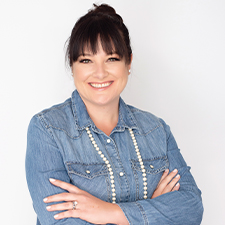
Surround Sound

University of Montana’s Focus is Fully on Students

Chief Marketing Communications Officer, University of Montana
Jenny Petty is an experienced marketing leader with a toolbox that includes extensive experience building and growing marketing teams, driving marketing strategy, content marketing and storytelling. At the University of Montana, they not only have a great story to tell, Jenny and her team are passionately sharing it with the world. As some higher education institutions face daunting times, Montana’s story is one of hope and optimism.
Jenny Petty left the corporate world where she worked with some of the world’s biggest brands including Dolly Parton, Family Guy, Harley Davidson, Phantom of the Opera and The Ellen DeGeneres Show and joined the world of higher ed marketing almost a decade ago. As the Chief Marketing Communications Officer at the University of Montana, Jenny is passionate about raising the profile of the marketing function within higher ed and modernizing the way they market to prospective students.
She can talk about inbound marketing all day long and was honored to be the winner of the 2021 eduWeb Summit Award for Industry Excellence. With a strong background and passion for branding, she was a key, driving force behind “The World Needs More Cowboys” campaign at the University of Wyoming and the “Montana Made. Montana Making” campaign at the University of Montana. Her expertise in branding, marketing strategy, and strategic communications is frequently called upon within the higher ed marketing industry. She finds joy in building teams and helping others grow, as well as flexing her creative muscles whenever she can.
Jenny is a graduate of the Reynolds School of Journalism and the University of Nevada and has a master’s degree in Organizational Leadership from Gonzaga University where her studies focused on the intersection of servant leadership and the marketing profession. She’s the host of “The Servant Marketer,” a podcast featuring marketing leaders, marketers, creatives, academics and entrepreneurs and shares thoughts on how marketers and leaders can serve first at servantmarketer.co.
How do you envision the University’s role in the future in light of emerging technologies and changing student needs?
The University of Montana’s mission can be boiled down to one phrase, “Inclusive prosperity.” This is the guidepost that informs all of our decision-making. As an access institution, we believe that everyone—no matter their background or identity—should have the ability to continue their education and reach their potential.
To be frank, with the decline in college-going rates in the U.S., our country is in trouble if that trend continues. In 30 years, with a less-educated populace, it is almost guaranteed that our children and grandchildren’s quality of life will be lower than ours. Therefore, we are embracing an agile mindset about how we can make higher education accessible to as many people as possible. We do that through our traditional on-campus offerings, but also through programs like AccelerateMontana, which has been designed to provide education and workforce development to Montana businesses.
I’d be remiss if I didn’t mention that we have an embedded community college that offers everything from culinary programs to CDL licensing to welding, so we truly are prepared to educate students no matter their interest, available time or needs.
With the pending demographic cliff, what strategies could be utilized to attract and retain students?
Student needs have significantly changed in the last few years. For traditional students, there is greater focus on well-being and mental health, and campuses are working hard to meet the needs of these students. But we still know that the number one indicator of whether a student will persist is if that student has their basic needs met and that they feel a sense of belonging.
At the University of Montana, we have focused on our brand experience and have looked at the whole lifecycle of a student. We’ve made investments in our digital experience, focusing on a prospective student website (UMontana.edu) that delivers highly personalized content and is focused on improving our overall brand experience. I believe the best tactic is to invest in building reputation and ensure that a campus experience—physical brick and mortar or online—delivers what the marketing messages promise.
Assuming branding is important for the University of Montana, how do you define and communicate the unique market that the university serves?
Branding is more important in higher ed than ever before. In a very crowded marketplace of schools offering almost identical educational products, an institution’s brand is the institution’s opportunity for differentiation.
At the University of Montana, we have spent a lot of time revitalizing our brand positioning to better reflect who we are. At its core, a brand is the public perception of who and what your organization is. Our new brand campaign, “Montana Made. Montana Making” has resonated because the project was collaborative and the campus community sees themselves in the physical and verbal expressions of the campaign.
The power of differentiation is in authenticity, which allows the brand to attract like-minded audiences who connect with you and your offering. For instance, the University of Montana has been ranked by Washington Monthly several times in the last couple of years as the number one school in the country for public service. That is a unique part of who we are and why we attract so many students who are motivated by service to people and our planet.
How are your strategies aligning with the changing demographics and preferences of prospective students?
Consumer expectations are rapidly changing based on the experiences consumers are having in other areas of life. So a student may expect to have the same experience they are having on Netflix or Amazon and these expectations are changing among all demographics.
We are a society that expects speed, personalization and excellent customer service no matter what product we are purchasing. Our digital strategies are focused heavily on personalization and ease of access. Too many universities speak to students in the exact same way—with the university at the center of the conversation. Our team changed the content to focus on the student and made the tone more informal.
Considering the financial challenges facing higher education, what alternative revenue streams should schools be exploring?
I think we often rely on increasing revenue through adding more services, more auxiliary functions, or programs. But the truth is, that to drive revenue, more universities need to make very hard decisions about the scope of what they offer and what they can maintain. When we move too far from our missions and values, we risk losing focus and focus is a gift that campus leaders can give to their institutions. So many schools need to do less, not more.
How has storytelling transformed the University of Montana’s approach to engaging with potential students and stakeholders?
Our team has adopted what is called the “surround sound” strategy when it comes to storytelling. We will take one piece of content and use it in a dozen different ways across platforms to ensure messaging pattern and saturation. This creates efficiency for our small team and allows us to craft one story into multiple pieces of content that can be tailored to different audiences.
We’ve also found that some of the most powerful prospective student content is user-generated, so we are elevating content created by our current students. Finally, we’re committed to being a resource for prospective students, no matter if they end up at the University of Montana or not. So we create content to help students on their journey.


